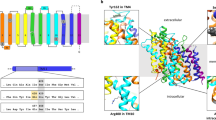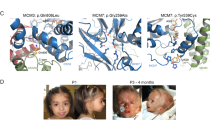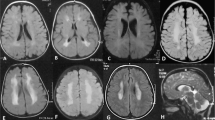Abstract
Thiamine-responsive megaloblastic anaemia (TRMA), also known as Rogers syndrome, is an early onset, autosomal recessive disorder defined by the occurrence of megaloblastic anaemia, diabetes mellitus and sensorineural deafness, responding in varying degrees to thiamine treatment1,2 (MIM 249270). We have previously narrowed the TRMA locus from a 16-cM to a 4-cM interval on chromosomal region 1q23.3 (Refs 3, 4) and this region has been further refined to a 1.4-cM interval5. Previous studies have suggested that deficiency in a high-affinity thiamine transporter may cause this disorder6,7. Here we identify the TRMA gene by positional cloning. We assembled a P1-derived artificial chromosome (PAC) contig spanning the TRMA candidate region. This clarified the order of genetic markers across the TRMA locus, provided 9 new polymorphic markers and narrowed the locus to an approximately 400-kb region. Mutations in a new gene, SLC19A2, encoding a putative transmembrane protein homologous to the reduced folate carrier proteins8,9, were found in all affected individuals in six TRMA families, suggesting that a defective thiamine transporter protein (THTR-1) may underlie the TRMA syndrome.
This is a preview of subscription content, access via your institution
Access options
Subscribe to this journal
Receive 12 print issues and online access
$209.00 per year
only $17.42 per issue
Buy this article
- Purchase on Springer Link
- Instant access to full article PDF
Prices may be subject to local taxes which are calculated during checkout




Similar content being viewed by others
References
Rogers, L.E., Porter, F.S. & Sidbury, J.B. Jr Thiamine-responsive megaloblastic anemia. J. Pediatr. 74, 494– 504 (1969).
Mandel, H., Berant, M., Hazani, A. & Naveh, Y. Thiamine-dependent beriberi in the thiamine-responsive anemia syndrome. N. Engl. J. Med. 311, 836–838 ( 1984).
Neufeld, E.J. et al. Localization of the gene for thiamine-responsive megaloblastic anemia syndrome on the long arm of chromosome 1 by homozygosity mapping. Am. J. Hum. Genet. 61, 1335–1341 (1997).
Raz, T. et al. Refine mapping of the gene for thiamine-responsive megaloblastic anemia syndrome in a 4cM region and evidence for genetic homogeneity. Hum. Genet. 103, 455–461 (1998).
Banikazemi, M. et al. Localization of the thiamine-responsive megaloblastic anemia syndrome locus to a 1.4-cM region of 1q23. Mol. Genet. Metab. 66, 193–198 (1999).
Rindi, G. et al. Further studies on erythrocyte thiamine transport and phosphorylation in seven patients with thiamine-responsive megaloblastic anemia. J. Inher. Metab. Dis. 17, 667–677 (1994).
Stagg, A.R. et al. Defective high-affinity transporter leads to cell death in TRMA syndrome fibroblasts. J. Clin. Invest. 103, 723–729 (1999).
Wong, S.C., Proefke, S.A., Bhushan, A. & Matherly, L.H. Isolation of human cDNAs that restore methotrexate sensitivity and reduced folate carrier activity in methotrexate transport-defective Chinese hamster ovary cells. J. Biol. Chem. 270, 17468– 17475 (1995).
Prasad, P.D., Ramamoorthy, S., Leibach, F.H. & Ganapathy, V. Molecular cloning of the human placental folate transporter. Biochem. Biophys. Res. Commun. 206, 681–687 (1995).
Altschul, S.F., Gish, W., Miller, E.W. & Lipman, D.J. Basic local alignment search tool. J. Mol. Biol. 215, 403– 410 (1990).
Kozak, M. Interpreting cDNA sequences: some insights from studies on translation. Mamm. Genome 7, 563–574 (1996).
Fleming, J.C. et al. The gene mutated in thiamine-responsive anaemia with diabetes and deafness (TRMA) encodes a functional thiamine transporter Nature Genet. 22, 305–308 (1999).
Hanson, R.L. et al. An autosomal genomic scan for loci linked to type II diabetes mellitus and body-mass index in Pima Indians. Am. J. Hum. Genet. 63, 1130–1138 ( 1998).
Concannon, P. et al. A second-generation screen of the human genome for susceptibility to insulin-dependent diabetes mellitus. Nature Genet. 19, 292–296 (1998).
Dib, C. et al. A comprehensive genetic map of the human genome based on 5,264 microsatellites. Nature 380, 152–154 (1996).
Gyapay, G., Ginot, F., Nguyen, S., Vignal, A. & Weissenbach, J. Genotyping procedures in linkage mapping. Methods 9, 91–97 ( 1996).
Boguski, M.S., Lowe, T.M.J. & Tolstoshev, C.M. dbEST-database for "expressed sequence tags". Nature Genet. 4, 332–333 (1993).
Acknowledgements
We thank the families; the Sanger Centre Mapping, Sequencing and Analysis teams, particularly C. Bird, for the finishing of PAC 206D15; S. Rhodes for the further analysis of the finished sequence; and E. Sprecher for critical reading of the manuscript. This work was supported by grants from the Juvenile Diabetes Foundation International, the Israeli Academy of Sciences and the Pittsburgh Technion Research Foundation (N.C.). V.L. is recipient of a post-doctoral fellowship from the Juvenile Diabetes Foundation International and from the Israeli Ministry of Sciences (in part).
Author information
Authors and Affiliations
Corresponding author
Rights and permissions
About this article
Cite this article
Labay, V., Raz, T., Baron, D. et al. Mutations in SLC19A2 cause thiamine-responsive megaloblastic anaemia associated with diabetes mellitus and deafness. Nat Genet 22, 300–304 (1999). https://doi.org/10.1038/10372
Received:
Accepted:
Issue Date:
DOI: https://doi.org/10.1038/10372
This article is cited by
-
Monogenic diabetes
Nature Reviews Disease Primers (2023)
-
A haplotype-resolved genome assembly of the Nile rat facilitates exploration of the genetic basis of diabetes
BMC Biology (2022)
-
Mutations in both SAMD9 and SLC19A2 genes caused complex phenotypes characterized by recurrent infection, dysphagia and profound deafness – a case report for dual diagnosis
BMC Pediatrics (2019)
-
Reduced thiamine binding is a novel mechanism for TPK deficiency disorder
Molecular Genetics and Genomics (2019)
-
Iron metabolism in erythroid cells and patients with congenital sideroblastic anemia
International Journal of Hematology (2018)



